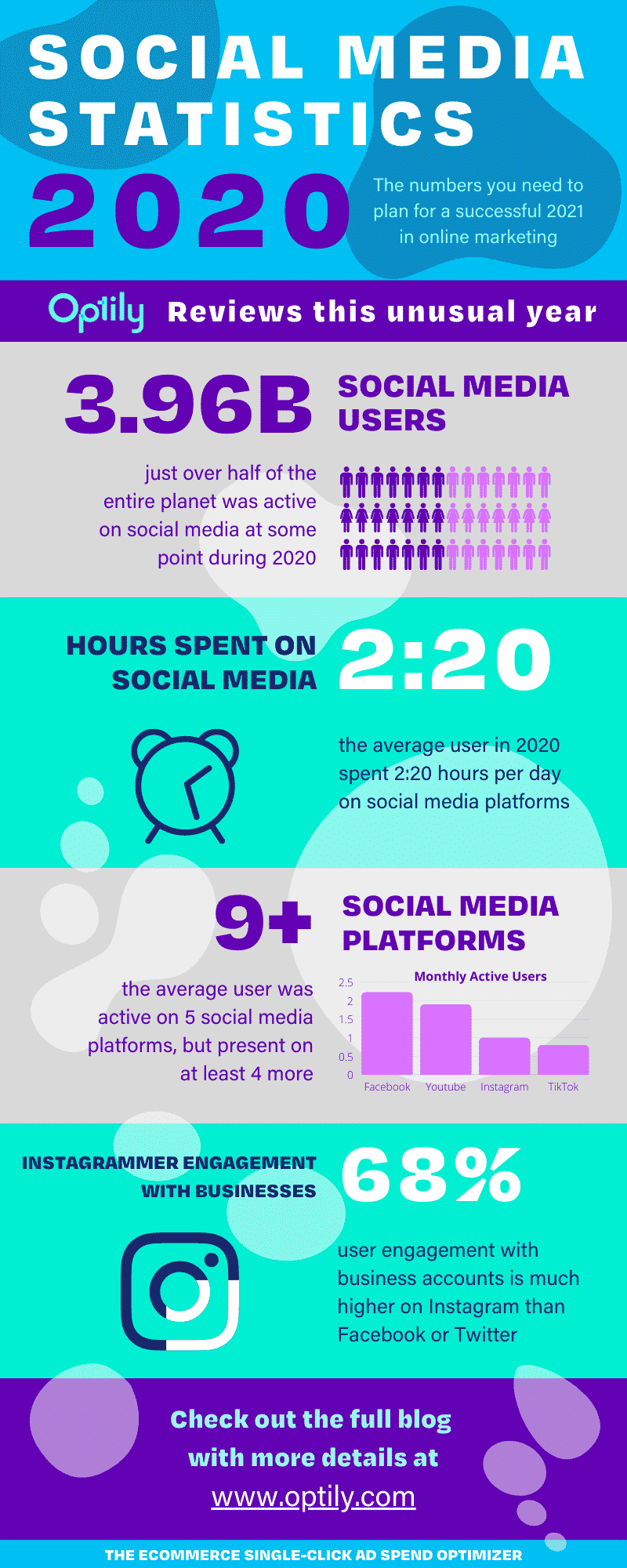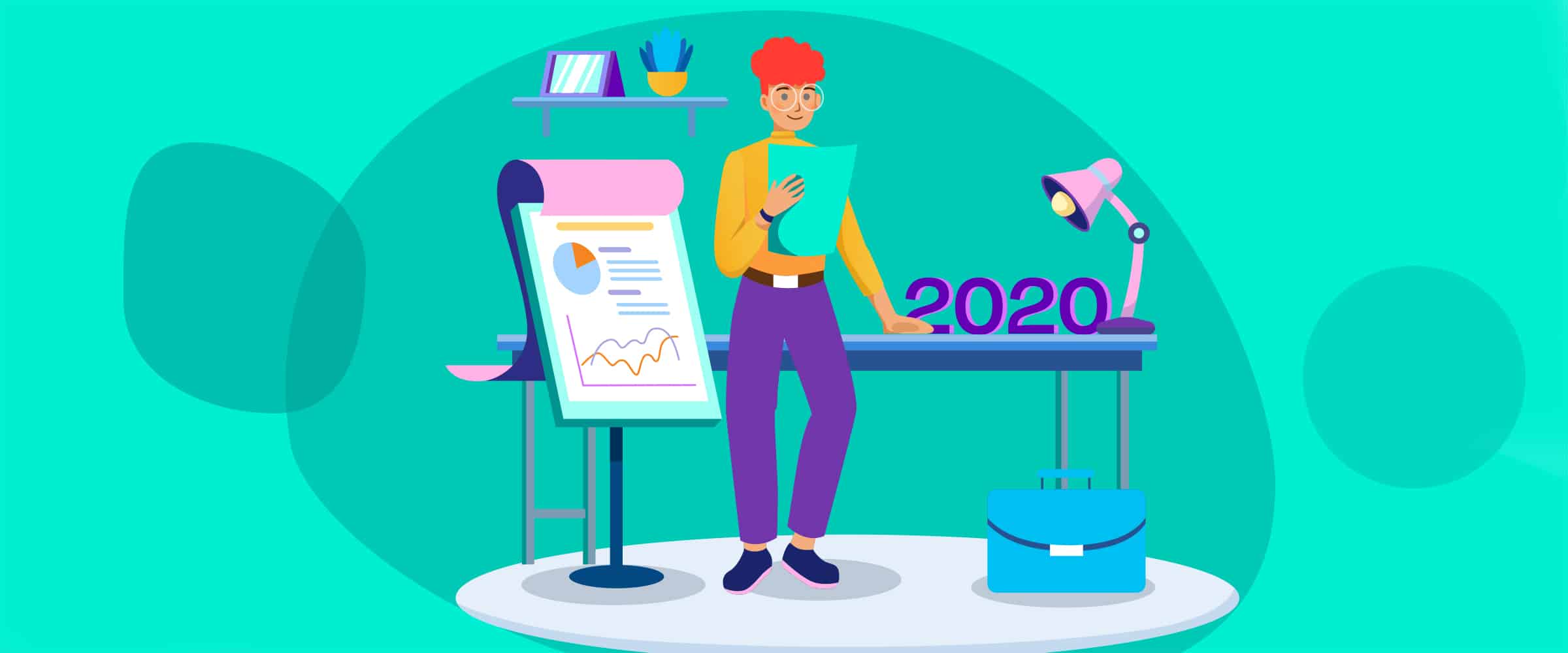2020 has been an unusual year to say the very least. It’s brought many challenges as well as new opportunities for businesses around the globe. We thought we’d round out the year with a look back the standout social media statistics of 2020. We’ve also summarized some of the stats in a shareable infographic below.
We saw a huge change in consumer culture with millions of customers switching to online shopping during the midst of the pandemic. With the surge of new online consumers came a giant opportunity for eCommerce stores and social media alike. Companies like Facebook, Instagram, Amazon, YouTube, and Twitter gathered millions of new members, all of which could be an opportunity for your business to advertise.
The reality of the situation is that although 2021 is a new year, many of the same trends will carry through from this year. That means that the digital revolution isn’t going anywhere and expects to see even more growth. If I can advise you to do one thing next year, it’s to freshen up your online presence across all platforms.
Here is a list of the biggest social media statistics of 2020 for you to browse, in the hopes that you can utilize them to optimize your digital marketing.
1. Half of the world were active social media users
Over half of the planet was active on social media in 2020. 3.96 billion people actively used social networks this year. This is an ~11% increase of users from the same time in 2019. Giving the strong growth seen this year, it isn’t expected to slow down any time soon.
Of all the social media statistics, this one alone should show you that with a potential audience that large, you should revamp your social media presence.
2. 2 hours and 20 minutes per day
On average people spend 2 hours and 22 minutes on social media every. single. day.
No, that wasn’t a typo, 2 hours and 22 minutes. No wonder there’s no time left in the day when we spend this much time on social media. That time is generally split over five main social medias:
40 minutes on YouTube
35 minutes on Facebook
25 minutes on Snapchat
15 minutes on Instagram
1 minute on Twitter
Knowing this information will allow you to focus your marketing efforts on areas that should grab the most attention from your target audience.
3. Mobile > Laptop
Given the fact that you are more than likely reading this blog on your phone or tablet, it probably comes as no surprise to you that the majority of internet users browse on their mobile devices. 3.3 billion of the 3.96 billion people who are active online prefer to view content on their mobile devices.
Having your website optimized for mobile devices is key to your business’s online success. Make sure to optimize your content so it works flawlessly on mobile to avoid running the risk of losing customers
4. Visual content is over 40 times more likely to get shared
Visual content is becoming the king of online content. It has seen exponential growth over the past two years, with more and more businesses pumping millions into the media stream. In 2020, 84% of all communication on social media was visual content consisting of videos, images, GIFs etc. If you want to attract your audience’s attention and make your brand stick in their heads, visual is the way to go.
But be careful, because 85% of Facebook videos are watched without sound. So be smart and get your message across without the need for sound.
5. 33% of consumers look to social media for more information on businesses & products.
Consumers are generally more cautious when buying online, after all they can’t see or feel the product before they buy it. Therefore, many of them use social media to research the reliability of businesses and products. Being active on social media will show customers you care about communicating with them and help build a strong relationship.
Interestingly, 49% of consumers depend on the recommendations of social media influencers to aid their purchasing decision. Connecting with well-known reviewers and influencers could be an effective way for your business to reach more customers.
6. Nine social media platforms per person
A typical person is active on at least five social media platforms, but present on four more. The last number of years we’ve seen the emergence of new social media to stand alongside the ol’ faithful ones.
TikTok is a new platform that was launched in 2016. Since then it has increasingly grown in size to 800 million active users. This places it ahead of well-known social media such as Snapchat, Twitter and LinkedIn in terms of size.
The ten largest social media in 2020 are:
Facebook (2.23 billion MAU)
YouTube (1.9 billion MAU)
WhatsApp (1.5 billion MAU)
Messenger (1.3 billion MAU)
WeChat (1.06 billion MAU)
Instagram (1 billion MAU)
QQ (861 million MAU)
TikTok (800 million MAU)
Tumblr (642 million MAU)
Qzone( 632 million MAU)
7. 68% of Instagram users engage with businesses
Half of Instagram’s users follow at least one business account. Instagram also has 58 times more engagement per follower than Facebook and 120 times more than Twitter. This makes Instagram a fantastic place to showcase your business. Customers are much more likely to engage with brands here than on any other social media account.
Instagram is also a hotspot for social media influencers. Keep both these things in mind when planning your next social media marketing campaign.
8. 50% of B2B buyers use LinkedIn when purchasing
LinkedIn has been considered for many years as a place for people to find new jobs. However, it is also a superb place for digital marketing. 70% of professionals describe LinkedIn as a trustworthy source of content, maybe this image of trustworthiness is the reason why people trust the site.
B2B buyers use LinkedIn as a major source of information when deciding to purchase a product or service. If your business is a B2B business then this is definitely something you should keep in mind to optimize your digital marketing return.
9. Know your audience by generation: Millennials on top
It’s not just teenagers who use social media. Especially during 2020, there has been a large increase of users across all age groups. Millennials once again at the generation with the highest social media use. They are also the group that are more likely to engage using a smartphone. Gen X, however, are more likely to be using tablets or other mobile devices. Baby Boomers, as we may expect, are the slowest to embrace the social media revolution, however, they are becoming increasingly more familiar.
The breakdown by generation as a percentage of population using social media is as follows:
94% of Millennials
77.5% of Gen Xers
48.2% of Baby Boomers
Knowing who your audience is, especially their age group, can help you get the best return on ad spend.
10. Over 90% of businesses have a social media account
This is one of the main social media statistics you really want to take to heart as a company. Don’t miss out on this opportunity. Over 91% of all businesses have at least one social media account. We know you want to stand out and not follow the crowd but this is an opportunity you can’t miss. Get online and be active.
How can you ensure you ace 2021 digital marketing?
Optily is the only single-click ad spend optimizer for eCommerce. Our plug-and-play online platform quickly links all of your Google and Facebook ads together and helps you easily determine which campaigns are working. With just one click, you can apply our optimization recommendations–like moving budget from a lower performing Google ad to a better performing one on Instagram.
Optily saves you time and money by instantly optimizing your ad spend.
Conclusion
There it is 2020 social media marketing all wrapped up. We hope you use these statistics to improve and optimize digital marketing for your business in 2021. If you follow these top tips for online advertising in 2021 you’ll be sure to have a profitable and successful year.
Social Media Statistics 2020:
Infographic Summary








